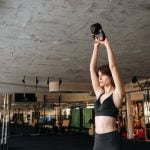Fitness models are revered for their enviable physiques and dedication to maintaining a healthy, fit lifestyle. One burning question that often comes to mind is: “How much do fitness models workout?” Understanding the rigorous routines of these individuals sheds light on the commitment required to achieve their sculpted bodies.
These individuals not only embody physical strength and endurance but also serve as inspiration for many aspiring fitness enthusiasts. Their workout schedules are meticulously planned and executed, emphasizing the significance of consistency, discipline, and hard work. A day in the life of a fitness model revolves around structured training sessions tailored to meet their specific goals and maintain peak performance.
From weight training to cardiovascular exercises and flexibility routines, fitness models engage in a variety of workouts to target different muscle groups and enhance overall fitness levels. The intensity of their workouts often includes high-intensity interval training (HIIT) and heavy lifting sessions, pushing their bodies to new limits while constantly striving for improvement. Rest days play a crucial role in their regimen, allowing for recovery and preventing burnout or injuries that could hinder progress towards their objectives.
A Day in the Life
Morning Routine
Fitness models typically start their day early to kick off their morning routine, which often includes a workout session. Many fitness models prefer to get their workouts done in the morning to set a positive tone for the rest of the day. The specific type of workout may vary depending on individual preferences and goals, but it usually involves a combination of strength training, cardio, or flexibility exercises.
Midday Activities
After their morning workout, fitness models may focus on other aspects of their career, such as photoshoots, meetings with clients or sponsors, or preparing meals that align with their nutritional goals. Staying active throughout the day is crucial for fitness models to maintain their physique and overall health. They may incorporate short walks or stretching breaks into their schedule to stay limber and energized.
Evening Training Sessions
In the evening, fitness models often have another training session scheduled to complete their daily workout routine. This could be another gym session targeting different muscle groups, a high-intensity interval training (HIIT) session, or a yoga class for recovery and relaxation. Consistency is key for fitness models to achieve and maintain their desired physique, so fitting in multiple workouts throughout the day is common practice among professionals in the industry.
Overall, fitness models lead incredibly disciplined lives when it comes to their workout routines. Their dedication to staying fit and healthy is evident in how they structure each day around physical activity while balancing other commitments related to their careers. The intense focus on maintaining peak physical condition requires careful planning and adherence to a strict regimen that encompasses various types of workouts designed to challenge different aspects of fitness.
Frequency
Fitness models are known for maintaining a rigorous workout routine to achieve their toned and sculpted physique. When it comes to the frequency of their workouts, fitness models typically train around 5 to 6 days per week. This consistent schedule is crucial for them to make progress towards their fitness goals and maintain their peak condition.
One of the reasons why fitness models work out so frequently is that consistency is key in achieving results. By training regularly, they can steadily improve their strength, endurance, and overall fitness levels. Moreover, frequent workouts help them stay disciplined and dedicated to their fitness journey, which is essential for success in the competitive world of fitness modeling.
In addition to physical benefits, working out regularly also has mental and emotional advantages for fitness models. Exercise is known to release endorphins, which can boost mood and reduce stress levels. For fitness models who often lead hectic lifestyles balancing training, photo shoots, and appearances, these mental health benefits are invaluable in helping them stay focused and motivated on their goals.
| Fitness Models’ Workout Frequency | 5-6 Days Per Week |
|---|---|
| Importance of consistency | Key for achieving results |
| Mental health benefits | Boosts mood and reduces stress levels |
Duration
Fitness models are known for their dedication to maintaining a fit and toned physique, which often raises the question: how much do fitness models workout? The duration of time spent working out each day can vary significantly based on the individual’s goals, training regimen, and schedule. While some fitness models may spend several hours in the gym every day, others may opt for shorter, more intense workouts to maximize efficiency.
To give you a better idea of the time commitment involved, here is a breakdown of the typical workout schedule for many fitness models:
- Morning: A fasted cardio session or high-intensity interval training (HIIT) workout to kickstart the metabolism
- Mid-morning: Weight training session focusing on different muscle groups each day
- Afternoon: Optional second cardio session or flexibility exercises such as yoga or Pilates
The total duration of these workouts can range from 1-3 hours per day, depending on the individual’s goals and preferences. Some fitness models may also incorporate active recovery days into their routine, such as hiking or swimming, to prevent overtraining and promote overall well-being.
It’s important to note that the length of time spent working out is not necessarily indicative of progress or results. What matters most is the quality and intensity of the workouts, as well as consistency in training.
Fitness models often tailor their workout duration based on specific goals, whether it’s building muscle mass, improving cardiovascular endurance, or preparing for a competition. Ultimate success in achieving their desired physique comes from a combination of smart training practices and proper nutrition.
Types of Workouts
Fitness models engage in a variety of workouts to achieve their desired physique and performance goals. One of the key components of a fitness model’s training regimen is weight training. This involves lifting weights to build muscle, increase strength, and improve overall body composition. Weight training can help fitness models develop the sculpted muscles and toned physique that are often associated with their profession. Additionally, weight training plays a crucial role in boosting metabolism and promoting fat loss.
Cardiovascular exercises are another essential aspect of a fitness model’s workout routine. Cardio workouts help improve cardiovascular health, increase endurance, and burn calories.
Fitness models often incorporate a combination of high-intensity interval training (HIIT), steady-state cardio, and circuit training to keep their workouts dynamic and challenging. HIIT, in particular, has gained popularity among fitness models due to its effectiveness in burning fat and improving cardiovascular fitness in a shorter amount of time compared to traditional steady-state cardio.
In addition to weight training and cardio, flexibility exercises are also an important component of a fitness model’s workout program. These exercises focus on improving flexibility, mobility, and range of motion, which can help prevent injuries and enhance overall performance during workouts.
Yoga, Pilates, and stretching routines are commonly included in a fitness model’s daily regimen to maintain optimal muscle function and joint health. By incorporating various types of workouts into their training routine, fitness models can achieve a well-rounded approach to physical fitness that enhances both their appearance and athletic abilities.
| Workout Type | Description |
|---|---|
| Weight Training | Lifting weights to build muscle, increase strength, and improve body composition. |
| Cardiovascular Exercises | Includes HIIT, steady-state cardio, circuit training to improve cardiovascular health and burn calories. |
| Flexibility Exercises | Focusing on improving flexibility, mobility, range of motion through yoga, Pilates, stretching routines. |
Intensity
Fitness models are known for their intense workout routines that help them achieve the sculpted and toned physique that is essential for their profession. One key aspect of a fitness model’s workout regimen is the intensity level at which they train.
Many fitness models incorporate high-intensity interval training (HIIT) into their workouts, which involves short bursts of intense exercise followed by brief periods of rest or lower intensity activity. This type of training has been shown to be effective in burning calories efficiently and improving overall cardiovascular fitness.
In addition to HIIT, fitness models also frequently incorporate lifting heavy weights into their workouts. Contrary to the common belief that heavy lifting will make individuals bulky, fitness models use heavy weights to build lean muscle mass and increase definition. By incorporating compound exercises like squats, deadlifts, and bench presses into their routines, fitness models are able to target multiple muscle groups simultaneously and maximize their time in the gym.
The combination of HIIT and heavy weightlifting allows fitness models to challenge their bodies in different ways, leading to continuous improvements in strength, endurance, and overall performance. It is this dedication to pushing themselves to new limits during each workout session that sets fitness models apart and helps them maintain their impressive physique.
So next time you wonder how much do fitness models workout, remember that their commitment to intense training plays a significant role in shaping their success in the industry.
Recovery
Fitness models often push themselves to the limit with their intense workout routines to achieve their desired physique for competitions, photoshoots, or social media content. However, what sets successful fitness models apart is not just their dedication to working out but also their commitment to proper recovery. Rest days are crucial for allowing the body to repair and rebuild muscle tissues, preventing burnout and reducing the risk of injuries.
Here are some important aspects of recovery that fitness models prioritize in their routines:
- Rest Days: Fitness models typically incorporate rest days into their weekly schedule to give their muscles a chance to recover. Depending on individual preferences and training intensity, some may opt for complete rest while others engage in active recovery such as yoga or light mobility exercises.
- Sleep: Adequate sleep is essential for muscle recovery and overall well-being. Fitness models understand the importance of getting enough quality sleep each night to support their fitness goals.
- Nutrition: Proper nutrition plays a key role in recovery for fitness models. Consuming protein-rich meals, staying hydrated, and including essential nutrients in their diet help replenish energy stores and promote muscle repair.
Additionally, fitness models may also incorporate various recovery techniques into their routine to optimize results and minimize fatigue. These techniques can include foam rolling, massage therapy, contrast baths (alternating between hot and cold water immersion), or even cryotherapy sessions. By prioritizing rest days and incorporating proper recovery techniques into their regimen, fitness models can maintain peak performance levels and sustain long-term progress in their fitness journey.
Adjusting for Shows and Shoots
In conclusion, the world of fitness modeling is not just about striking a pose or looking a certain way; it requires dedication, hard work, and consistency in workout routines. Fitness models have grueling schedules that revolve around their training, ensuring they maintain their physique and peak condition. The question “How much do fitness models workout?” can be answered by understanding the commitment these individuals have towards their physical fitness.
Fitness models typically engage in training sessions multiple times a week to stay on top of their game. Consistency is key in their workout routines as they strive to push themselves to new limits and achieve their desired goals. The duration of their workouts may vary based on individual objectives, from maintaining lean muscle mass to shredding for a competition or photoshoot.
Moreover, fitness models incorporate various types of workouts into their routine, including weight training, cardio exercises, and flexibility movements. The intensity of their workouts cannot be understated, with many embracing high-intensity interval training (HIIT) and heavy lifting to challenge themselves physically and mentally. However, amidst all the hard work, rest days are crucial for recovery to prevent burnout and injury.
As fitness models adjust their workouts leading up to shows and shoots, they also make necessary diet adjustments and training tweaks to ensure they are in peak physical condition when it matters most. Ultimately, the dedication and discipline displayed by fitness models in their workout routines serve as an inspiration for others looking to improve their own fitness journey.
Frequently Asked Questions
How Many Hours Do Models Workout?
Models typically workout anywhere from 3 to 5 hours per week, depending on their schedule and goals. Some may opt for shorter, intense workouts while others prefer longer, more moderate exercise sessions.
What Is the Fitness Routine for Models?
The fitness routine for models usually includes a combination of cardio, strength training, and flexibility exercises. Cardio helps them stay lean, strength training builds muscle tone, and flexibility exercises ensure they maintain a long and lean physique.
How Do Fitness Models Get So Lean?
Fitness models get so lean by following a strict diet and workout regimen. They focus on eating clean, whole foods that are high in nutrients but low in calories. Additionally, they engage in regular exercise that increases their metabolism and burns excess fat, leading to a shredded appearance.

Passionate about providing useful information to anyone with an interest in the field of Personal Training, I strive to pass on to our readers quality information and to answer any questions about Personal Trainers, the work they do and how to become one.





